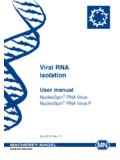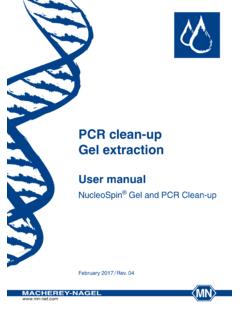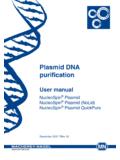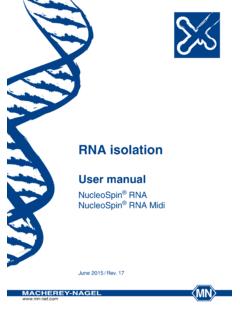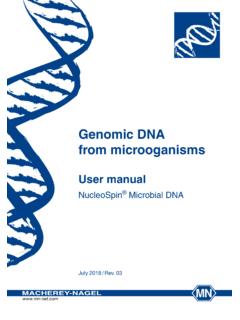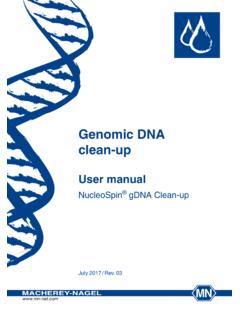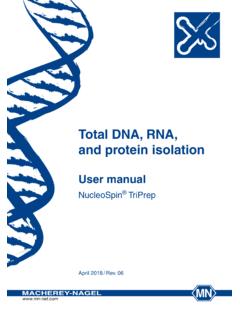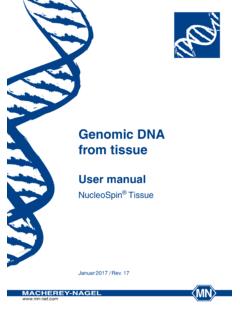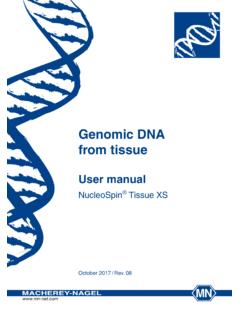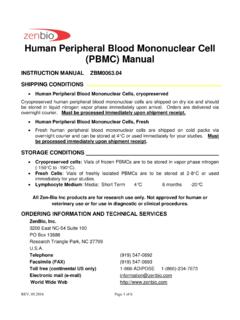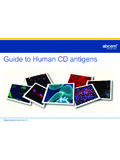Transcription of RNA isolation - Macherey-Nagel AG
1 MACHEREY-NAGELEN ISO 9001EN ISO 13485 CERTIFIEDMACHEREY-NAGEL GmbH & Co. KG Neumann-Neander-Str. 6 8 52355 D ren GermanyFrance: Macherey-Nagel EURLTel.: +33 388 68 22 68E-mail: AGTel.: +41 62 388 55 00E-mail: international:Tel.: +49 24 21 969-0E-mail: : +1 484 821 0984E-mail: isolationUser manualNucleoSpin RNA XSSeptember 2015 / Rev. 09 Macherey-Nagel GmbH & Co. KG Neumann-Neander-Str. 6 8 52355 D ren Germany Tel.: +49 24 21 969-270 Fax: +49 24 21 969-199 isolationProtocol-at-a-glance (Rev. 09)XSNucleoSpin RNA XS1 Supply sampleUse up to 105 cultured cells or 5 mg tissue samples2 Lyse and homogenize cells100 L RA1 2 L TCEPMix3 Add Carrier RNA5 L Carrier RNA working solutionMix4 Filtrate lysate (optional)
2 11,000 x g, 30 s5 Adjust RNA binding condition100 L 70 % ethanolMix6 Bind RNALoad lysate11,000 x g, 30 s7 Desalt silica membrane100 L MDB11,000 x g, 30 s8 Digest DNA25 L DNase reaction mixtureRT, 15 min9 Wash and dry silica membrane1st wash100 L RA2 RT, 2 min 11,000 x g, 30 s2nd wash400 L RA3 11,000 x g, 30 s3rd wash200 L RA3 11,000 x g, 2 min10 Elute highly pure RNA10 L RNase-free H2O11,000 x g, 30 s 3 Macherey-Nagel 09 / 2015, Rev. 09 RNA isolationTable of contents1 Components Kit contents Reagents, consumables, and equipment to be supplied by user About this user manual 52 Product description The basic principle Kit specifications Handling, preparation, and storage of starting materials Elution procedures Stability of isolated RNA 103 Storage conditions and preparation of working solutions 114 Safety instructions 135 Protocols RNA purification from cultured cells, laser captured cells.
3 Or microdissected cryosections RNA purification from tissue Clean-up and concentration of RNA rDNase digestion in the eluate 256 Appendix Troubleshooting Ordering information References Product use restriction / warranty 32 Macherey-Nagel 09 / 2015, Rev. 094 RNA isolation1 Components Kit contentsNucleoSpin RNA XS REF10 preps preps preps Buffer RA16 mL25 mL125 mLWash Buffer RA2 2 x 1 mL15 mL2 x 15 mLWash Buffer RA3 (Concentrate)*6 mL12 mL50 mLMembrane Desalting Buffer MDB10 mL10 mL50 mLReaction Buffer for rDNase7 mL7 mL30 mLrDNase, RNase-free (lyphilized)*1 vial (size A)1 vial (size C)2 vials (size D)Carrier RNA*300 g300 g300 gReducing Agent TCEP*14 mg3 x 14 mg2 x 107 mgRNase-free H2O13 mL13 mL13 mLNucleoSpin Filters (violet rings)1050250 NucleoSpin RNA XS Columns (light blue rings plus Collection Tubes)1050250 Collection Tubes (2 mL)30150750 Collection Tubes ( mL)
4 1050250 User manual111* For preparation of working solutions and storage conditions see section 09 / 2015, Rev. 09 RNA Reagents, consumables, and equipment to be supplied by userReagents 96 100 % ethanol (to prepare Wash Buffer RA3 and for the clean-up procedure, section ) 70 % ethanol (to adjust RNA binding condition)Consumables mL microcentrifuge tubes Sterile RNase-free tipsEquipment Manual pipettors Centrifuge for microcentrifuge tubes Vortex mixer Personal protection equipment (lab coat, gloves, goggles) About this user manualIt is strongly recommended reading the detailed protocol sections of this user manual if the NucleoSpin RNA XS kit is used for the first time. Experienced users, however, may refer to the Protocol-at-a-glance instead.
5 The Protocol-at-a-glance is designed to be used only as a supplemental tool for quick referencing while performing the purification procedure. All technical literature is available on the internet at Please contact Technical Service regarding information about changes of the current user manual compared to previous 09 / 2015, Rev. 096 RNA isolation2 Product The basic principleOne of the most important aspects isolating RNA is to prevent degradation of the RNA during the isolation procedure. With the NucleoSpin RNA methods, cells are lysed by incubation in a solution containing large amounts of chaotropic ions. This lysis buffer immediately inactivates RNases which are present in virtually all biological materials and creates appropriate binding conditions which favor adsorption of RNA to the silica membrane.
6 Contaminating DNA, which is also bound to the silica membrane, is removed by an rDNase solution which is directly applied onto the silica membrane during the preparation (RNase-free rDNase is supplied with the kit). Simple washing steps with two different buffers remove salts, metabolites and macromolecular cellular components. Pure RNA is finally eluted under low ionic strength conditions with RNase-free H2O (supplied). The RNA preparation using NucleoSpin RNA kits can be performed at room temperature. The eluate, however, should be treated with care because RNA is very sensitive to trace contaminations of RNases, often found on general lab ware, fingerprints and dust. To ensure RNA stability, keep RNA frozen at -20 C for short-term or -70 C for long-term Kit specifications The NucleoSpin RNA XS kit is recommended for the isolation of RNA from very small samples.
7 Typical sample material comprises small amounts of cells (up to 1 x 105) and tissue (up to 5 mg) such as pellets of cultured cells, laser-captured cells, microdissected cryosections, biopsy samples, fine needle aspirates, and flow cytometer sorted cells (Table 1, page 7). The innovative column design with a funnel shaped thrust ring and a small silica membrane area allows elution of RNA in as little as 5 30 L. Thus, highly concentrated RNA is eluted, ready for common downstream applications ( , RT-PCR). The RNA yield strongly depends on the sample type, quality, and amount (see Table 2, page 8 for details). High quality RNA (RNA Integrity Number (RIN) > 9 according to Agilent 2100 Bioanalyzer assays) can be obtained from small samples ( , 103 cells, mg tissue) as well as from larger samples (105 cells, 5 mg tissue).
8 RRNA ratios (28S / 18S) of can be obtained. Since RNA quality always depends on the sample quality, see section for further aspects. The NucleoSpin RNA XS kit allows purification of RNA with an A260/A280 ratio generally exceeding (measured in TE buffer pH ). Due to the high RNA purity large amounts of eluates can be used as template in RT-PCR without inhibition ( , 8 L of 10 L eluates as template in a 20 L qRT-PCR setup generating stronger signal compared to reactions with less template in a LightCycler PCR with the Sigma SYBR Green Quantitative RT-PCR Kit). 7 Macherey-Nagel 09 / 2015, Rev. 09 RNA isolation The preparation time is approximately 45 min for 12 samples. As Reducing Agent TCEP (Tris(2-carboxyethyl)phosphine) is supplied in the kit.
9 TCEP is odorless, more stable, more specific for disulfide-bonds, and less toxic than other commonly used reducing agents. Carrier RNA (poly(-A) RNA: poly(A) potassium salt, prepared from ADP with polynucleotide phosphorylase) is included for optimal performance with smallest samples. It is recommended adding Carrier RNA to the sample lysate (20 ng per sample). Such small amounts typically do not interfere with subsequent RT-PCR, even in oligo-dT primed reverse transcriptions. The small amount of Carrier RNA transfered into a reverse transcription reaction is commonly not significantly influencing the outcome of the reaction, due to the large excess of oligo-dT primer. The benefit of adding Carrier RNA to the sample lysate depends on sample type, amount, and kind of downstream RNA analysis.
10 Carrier RNA should be omitted when subsequent to RNA isolation - a poly-A RNA isolation is performed - RNA sequencing is performed. rDNase is supplied in the kit. DNA contaminations are removed by on-column digestion with rDNase. For most demanding applications ( , expression analysis of plasmid transfected cells, plastidial or mitochondrial genes) a subsequent digestion with rDNase in the eluate is 09 / 2015, Rev. 098 RNA isolationTable 1: Kit specifications at a glanceParameterNucleoSpin RNA XSFormatMini spin column XS designSample materialSmall amounts of tissue < 5 mg tissue, < 100 000 cultured cellsFragment size> 200 ntTypical yieldSee table 2 for examplesA260 RIN (RNA integrity number)> 9 (depending on sample quality)Elution volume5 30 LPreparation time35 min/6 prepsBinding capacity110 gTable 2: Overview on average yields of RNA isolation using NucleoSpin RNA XSSampleAverage yield105 HeLa cells1000 1500 ng104 HeLa cells100 150 ng103 HeLa cells10 15 ng102 HeLa ng5 mg mouse kidney5 8 g1 mg mouse kidney2 g9 Macherey-Nagel 09 / 2015, Rev.
